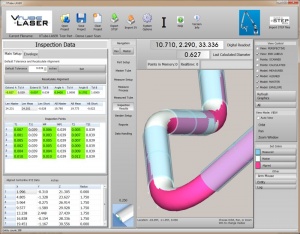Difference between revisions of "End-Scan Using the Scissor Motion"
From ATTWiki
(→Other Pages) |
(→Why the End-Scan technique is important) |
||
| Line 24: | Line 24: | ||
<br><br> | <br><br> | ||
We also recommend the [[End-Scan Using the End Wall]] technique and the most precise [[End-Scan Using End Targets]]. | We also recommend the [[End-Scan Using the End Wall]] technique and the most precise [[End-Scan Using End Targets]]. | ||
| + | </td> | ||
| + | <td width=300> | ||
| + | </td> | ||
| + | </tr> | ||
| + | </table> | ||
| + | |||
| + | |||
| + | ===Measure Setup=== | ||
| + | <table cellpadding=10> | ||
| + | <tr valign=top> | ||
| + | <td width=500> | ||
| + | * Set System Options, Measure 2 Tab, "Maximum Number of LLP Points in String" to 3 | ||
| + | * Set Measure Setup - LASER Tab: The LASER defaults to ON for CYLINDERS and END-SCANS.<br><br> | ||
| + | * Set Measure Setup - LASER Tab Value: Cylinder stripes = 3 to 5 | ||
| + | * Set Measure Setup - LASER Tab Value: End-scan stripes = 5 | ||
| + | * Set Measure Setup - LASER Tab Value: Split bend stripes = 5 | ||
| + | * Set VTube-LASER so that the Scan Rates are set to TIMER for all scan types.<br><br> | ||
| + | * Set VTube-LASER so that the Scan Rates TIMER is set to 0 for all TIMERS.<br><br> | ||
</td> | </td> | ||
<td width=300> | <td width=300> | ||
Revision as of 23:53, 28 January 2012
|
|
Why the End-Scan technique is important
|
This end-scan method is useful for ease-of-use and quickness.
|
Measure Setup
|
How To Use This End-Scan Technique
|
Other Pages
- See also End-Scan Using the End Wall
- See also End-Scan Using End Targets
- Back to VTube-LASER



